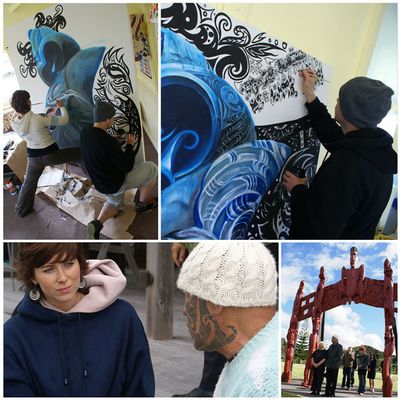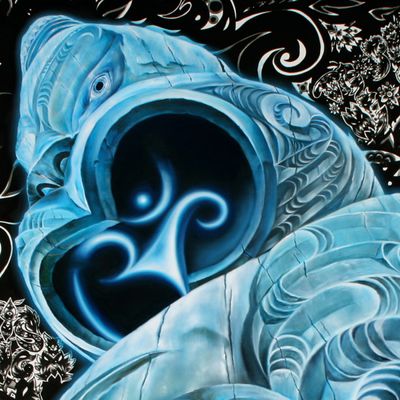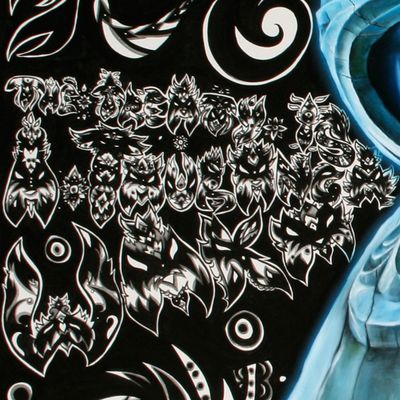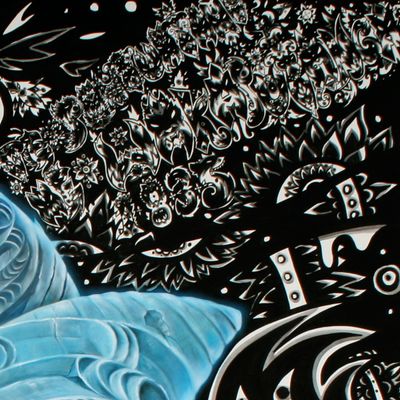







Te Pou Tuatahi
$3,750.00
Explore the story of the artwork >>
Print sizes and editions
- Regular museum archival paper print - 700 x 700mm (limited to 275)
- Large museum archival paper print - 905 x 905mm (limited to 195)
- Extra Large museum canvas print - 1100 x 1100mm (limited to 175)
Your unique limited edition fine art print
- Sofia Minson creates your exclusive signed print
- We ship for $25 in NZ and from $50 internationally
- Your artwork arrives rolled, ready to be framed - do you need help? Request framing guidance
Original painting SOLD, by Sofia Minson and Samapeap Tarr, oil, acrylic and flashé on canvas, 2075 x 2075mm, 2009. Contact us to enquire about the original.
The story of Te Pou Tuatahi
This painting was created by Sofia Minson and Samapeap Tarr, a graffiti artist of Cambodian and New Zealand heritage. The collaboration was filmed for the documentary 'Canvassing the Treaty' which aired on Māori TV on Waitangi Day in 2010 and at the FIFO international film festival in 2011.
Sofia's oil painting of the central blue carved 'pou' in this artwork represents her Ngāti Porou ancestors' waka. The Sanskrit symbol for Om, which is the sound of the universe, is spoken to us from the mouth of the ancestral figure.
Surrounding the painting are Peap's black ink designs influenced by Cambodian legends of the Naga snake. He has also written the words "Te Pou Tuatahi He Wakaputanga 1835" and "The Treaty is a Tauranga Waka." More about this below.
The 'Canvassing the Treaty' Project
The thought provoking art and social experiment follows six New Zealand artists, three Māori and three non-Māori, as they gain deeper insights into Te Tiriti o Waitangi (The Treaty of Waitangi) and create cross-cultural collaborative artworks over one weekend at Te Tii marae in Northland.
The Artists
It all began with the artists driving an hour and a half north of Auckland to a windswept cliff-top property at Pakiri. There they participated in an intensive wānanga to learn about the Treaty of Waitangi from Moana Jackson and Ingrid Huygens, two experienced treaty educators.
"I learnt more about New Zealand's history in one day than I had in all my years at school.
The depth of knowledge and considered social and historical perspectives shared that day was priceless."
- Sofia Minson
The artists were then paired up. Sofia who is of Ngāti Porou, Swedish, English and Irish descent was to collaborate with Peap, to produce an artwork inspired by ideas about the treaty.
He Wakaputanga 1835 - A Proclamation of Sovereignty
On the right side of the painting Peap has written the words "Te Pou Tuatahi He Wakaputanga 1835." 'Te Pou Tuatahi' means 'The First Pillar' and this statement means that the founding legal document for Aotearoa is He Wakaputanga - The Proclamation of Sovereignty.
This internationally legal Proclamation of Sovereignty was signed between 1835 and 1839 by 52 rangatira, who were leading chiefly representatives of self-governing, sovereign hapū or clans throughout New Zealand. Together with this document they established their own "collective" or "association."
Te Tii Marae
The condensed two and a half day process of creating this collaborative artwork took place at the historically significant Te Tii Marae.
Te Tii was the meeting ground where in 1840, five years after The Proclamation of Sovereignty was created, rangatira from many iwi debated the merits of a new treaty on the night before it was signed.
The Māori treaty text 'Te Tiriti o Waitangi' confirms Māori authority and sovereignty and allows a limited legal and administrative system to govern British migrants. This document was signed up the road from Te Tii Marae at Waitangi by 43 rangatira. It was then taken around the country where another 500 signatures were gathered.
The Treaty is a Tauranga Waka
With black ink characters, Peap has written on the left side of the painting "The Treaty is a Tauranga Waka." This means that the 1840 Tiriti was New Zealand's first legal immigration document.
Te Tiriti affirms the position of various iwi as absolute sovereign states, and welcomes the crown to become its own iwi and to govern and administer its own people migrating to Aotearoa.
'Waka' means vessel and 'Tauranga' means anchorage or a place to land. In essence the document itself is a 'Tauranga Waka' or a landing place. Te Tiriti is a vessel designed to pull people in who are newly arriving into the territory.
Pou Symbolizing Ngāti Porou Waka
The subject of Te Pou Tuatahi is an exaggerated representation of a pou (carved post) symbolizing Sofia's Ngāti Porou ancestors' waka 'Horouta'. The pou of Horouta stands in a line up of ten poupou at the grounds at Te Tii and together they represent the great waka traditions linking Aotearoa with the Pacific.
"The pou in Te Pou Tuatahi is a waka of inclusiveness, not exclusiveness."
- Sofia Minson
Sofia found the link between the idea of 'tauranga waka' and Te Tiriti o Waitangi very interesting. The carving in this painting celebrates the spirit of this - that land and this world is meant to be shared.
Ancestral Consciousness
On another level, Sofia sees the pou as being our ancestors speaking to us with the consciousness of the next world. The mouth is wide and is a void of blackness. Within that blackness is the Sanskrit symbol Aum (Om). Our ancestors are giving us the profound and unifying message of Aum, which is literally the resonating sound of the universe.
"The whole world has evolved from Aum
The whole world is sustained by Aum
The whole world will merge into Aum"
- Sivayave
Guru Sri Chinmoy said that the role of consciousness is to deepen silence and to expand sound. In his Colour Kingdom book the colour turquoise is connected with the idea of consciousness. The turquoise light glowing from the carved figure in the painting signifies the embodiment of a higher consciousness.
The Eye of a Whale
The figure's eye in the painting is the eye of a humpback whale. Whales are believed to have mass consciousness, not individual consciousnesses like humans do. That means, if something happens to one whale, it is somehow known to the rest.
The deeply peaceful presence emanating from whales, which is palpable to divers fortunate enough to experience close contact, can raise the vibration and compassion of humankind. Some believe the sacrifice that whales make in beaching themselves is also in order to share their spirit and the high frequency of their oceanic realm with the earth.
The figure in the painting has essentially the same role as the humpback whale, as guardian and transmitter of knowledge to human beings.
Sofia Minson Paintings | New Zealand Artwork

